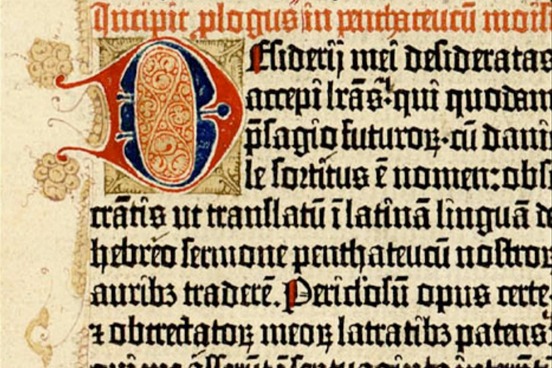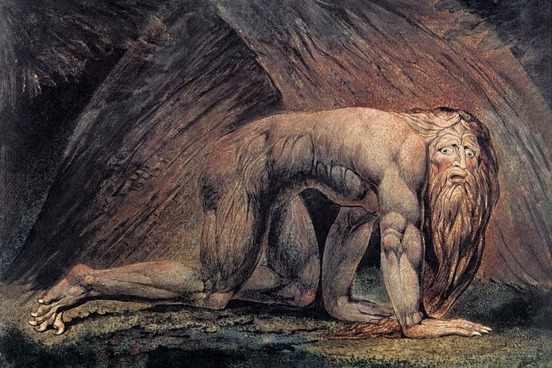
Red-letter
The Gutenberg Bible is having a red-letter day: tradition holds that Johannes Gutenberg printed the first copy of the Latin Vulgate Bible on February 23, 1455, in Mainz, Germany.
The Gutenberg Bible was most famous for being the first book in Western Europe to have been printed on a printing press with metal, movable type. It was a new technology, and Gutenberg experimented with it during the typesetting and printing of his Bible. One experiment he undertook was two-color printing.
It was a common thing in hand-lettered books and manuscripts for important texts (and particularly texts that introduced a new chapter) to be lettered in red. This is called rubrication, from the Latin ruber, meaning "red," and the headlines themselves came to be known as rubrics. Gutenberg attempted to automate rubrication, but the process (which required a page be passed through the press twice) was too time-consuming to do for an entire Bible. There are only a handful of pages in the surviving copies of the Gutenberg Bible that are mechanically rubricated. This practice wasn't restricted to Bibles, though: important feast days in the Christian liturgical calendar were often rubricated so they were easier to spot. These important feast days came be to known as red-letter days, and we use the adjective red-letter now to refer to something of special significance.

Nimrod
"Cush became the father of Nimrod; he was the first on earth to become a mighty warrior. He was a mighty hunter before the Lord." —Genesis 10:8-9, NRSV
Modern Americans may read that verse and cringe: most people who know the word nimrod know it as a synonym of idiot. But when nimrod first entered English, its meaning was not so harmless.
Though the biblical record on Nimrod is thin, early Christian and Jewish traditions hold that Nimrod ascribed his strength to himself and not God, and in his self-adulation he became a tyrannical ruler. Medieval Jewish and Islamic stories of confrontations between righteous Abraham and evil Nimrod only strengthened this view, and by the time the word nimrod was adopted into English in the 1500s, it was in reference to a tyrant.
Of course, Nimrod's other claim to fame was as a hunter, and so the word nimrod also very quickly came to be used of avid hunters.
But how did we jump from hunting to fools? We're not entirely sure. Some etymologists ascribe the origin of the "fool" meaning to Bugs Bunny, who supposedly taunts his hapless hunter/nemesis, Elmer Fudd, by calling him a "nimrod." Other etymologists claim the word acquired this meaning in a 1933 play called "The Great Magoo." And still others link the "idiot" meaning to the idea of Nimrod's self-aggrandizing and tyranny, which are unwise life choices in the biblical worldview.

Wine bottles
The Bible is full of marvelous names—Jehoshaphat, anyone?—and we remember a few of the most notable ones in an odd way: we use their names to refer to larger-than-average champagne bottles.
Most casual drinkers know about the standard 750ml bottle, and they might be familiar with the term magnum (which is used of an extra-large bottle that holds about 1.5 liters, or two bottles). But only oenophiles know about the larger-sized bottles named for notable figures from the Bible.
The jeroboam usually holds about four bottles (unless the wine is a Bordeaux, and then it holds six bottles), and is named for the first king to rule over the northern kingdom of Israel after the formerly united nation split into northern and southern kingdoms.
A rehoboam holds six bottles and is named for Jeroboam's counterpart in the southern kingdom of Judah, Rehoboam.
A methuselah holds eight bottles and is named for the patriarch Methuselah, who was the grandfather of Noah and was reckoned as having lived for 969 years.
With the salmanazar (holding about 12 bottles), we move away from Jewish kings and patriarchs to other notable figures in biblical history. The salmanazar is named for King Shalmaneser IV of Assyria, who conquered the ancient region of Samaria and held it under tribute.
A balthazar holds about 16 bottles and is named for King Belshazzar of Bablyon, whose first appearance in the Scriptures features him, appropriately enough, drinking wine.
The nebuchadnezzar holds a whopping 20 bottles and is named for Nebuchadnezzar II, the king of Babylon who sacked Israel and carried the Jews away into captivity.
If you're interested in serving an entire wedding reception in one go, there's always the melchior, which holds 24 bottles and is named for one of the magi who visited Jesus at his birth, bearing gifts from the east.

Golden calf
"Arms control, however, has ceased to be a subject of legitimate disputation and has evolved instead into an object of veneration, the golden calf of liberalism."
—Patrick J. Buchanan, Newsweek, 30 March 1987
The phrase golden calf doesn't appear much in print, but when it does, it's used to refer to something that is venerated or held in the highest regard. But there's a negative connotation to golden calf: whatever is being worshipped is thought to be unworthy of such devotion.
The phrase is pulled straight from the book of Exodus. As the story goes, after the people of Israel fled captivity in Egypt, God led them to Mt. Sinai and called Moses up to the top of the mountain, where God would give him two stone tablets containing the law and the commandments of God, written by the hand of God.
As you can imagine, there's no rushing God; Moses was absent from the people of Israel for forty days and nights. In his absence, the people grew restless. They approached Moses' brother Aaron and asked him to make gods for them so that they had someone to lead them through the wilderness, since Moses had evidently left them. Aaron collected all the gold jewelry from the Israelites, melted it down, and made a golden calf for them to worship, which they promptly did.
God encouraged Moses to get back down to his people, since in his absence they had begun worshipping an idol, and he later brought a plague to afflict the Israelites for their rebellion.
The phrase golden calf has been used metaphorically of something unworthy of devotion since the early 1300s.

Scapegoat
"He describes Noah as a scapegoat, 'someone easy to point fingers at when you're searching for a villain.'" —Ethan Renner, BaltimoreSun.com, 6 Dec. 2015
We all know (or have been) a scapegoat, a person who takes the blame for something that isn't their fault. But there was, at one point in Israel's history, an actual goat that was the scapegoat.
After the Israelites were delivered out of Egypt, God took some time to enumerate various laws to his people and their priests, including a number of laws about proper worship. In this list of ritual law, God ordains a particular day during which the entire nation of Israel would set aside work, and during which the priests would atone for the sin of the whole nation. Among the rituals prescribed was the scapegoat:
And Aaron shall cast lots upon the two goats; one lot for the Lord, and the other lot for the scapegoat. And Aaron shall bring the goat upon which the Lord’s lot fell, and offer him for a sin offering. But the goat, on which the lot fell to be the scapegoat, shall be presented alive before the Lord, to make an atonement with him, and to let him go for a scapegoat into the wilderness. —Leviticus 16:8-10, KJV
The priest was instructed to lay his hands on the scapegoat and confess the nation's sin over it. Then the goat was chased off into the wilderness, where it carried the sin of the people with it.
The English scapegoat is a compound of the old-fashioned verb scape, which means "escape," and goat, and is modeled on a misreading of the Hebrew ʽazāzēl (which is probably the name of a demon) as ʽēz 'ōzēl , "the goat that departs." (More modern translations render scapegoat in this text as "Azazel.")
This day of atonement became known as Yom Kippur, though the sacrifice of the scapegoat hasn't been performed since the destruction of the Second Temple in Jerusalem by Romans in 70 AD.

Talent
"Talent hits a target no one else can hit; Genius hits a target no one else can see." Arthur Schopenhauer (in translation), The World as Will and Representation, 1844.
We tend to think of talent as something ineffable and intangible, but the original talent was anything but. When talent first came into English in the 9th century, it referred to an ancient unit of weight, and an ancient unit of money corresponding to that weight. (The actual values of talents were variable from civilization to civilization.)
The jump from an ancient currency to a person's natural abilities is not as big as one would think. In the Gospel of Matthew, Jesus tells a parable about a landowner who is leaving town and entrusts his property to his slaves and servants. He hands out talents (money) in accordance with each person's abilities, so to those from whom more is expected, more money is given. One slave is given five talents; he trades with them and makes five more. Another is given two talents, and he too trades with them and doubles his master's money. A third is given one talent; he buries it for safekeeping. When the master returns, he praises the servants who increased his wealth, and upbraided the servant who buried his talent, taking the servant's one talent and giving it to the servant who had ten talents. Jesus ends the parable with the teaching, "For to all those who have, more will be given, and they will have an abundance; but from those who have nothing, even what they have will be taken away."
The connection between ability and the word talent was inseparable, and by the 1400s the English word for the currency had come to refer to a person's natural abilities or aptitudes.

Maudlin
"The Academy members may vote more with their hearts than with their minds, the speeches may be ungainly and maudlin, the outfits outlandish—but it's all irresistible." —Scott Busby, Entertainment Weekly, 22 March 1991
We associate maudlin with weepy sentimentality, and it has been used that way since the 1600s. But prior to that, maudlin was a name.
The Gospels all mention a woman named Mary Magdalene as one of Jesus' followers. Two of the Gospels say that Jesus cast seven demons out of her; all four of the Gospels identify her as the first of Jesus' followers to see him after his resurrection. She has also historically been identified as the unnamed woman in the book of Luke who washes Jesus' feet with her tears and dries them with her hair, though the passage does not actually name the weeping woman.
As the first of Jesus' followers to see him after his resurrection, Mary Magdalene took on special significance in the early Christian church and has been revered as a saint since the church's early days. Many representations of Mary Magdalene show her weeping, and by the early 1600s, her name became synonymous with "teary." For this particular meaning, we kept the medieval English spelling of her name: maudlin.
It's not the only meaning her name has been given. Because the woman in Luke is also identified as a sinner, magdalene became a synonym for a "fallen woman," though this use is outdated.
Magdalene itself is toponymic; it is ultimately from the Greek Magdalene, which means "of Magdala."

Simony
"...Pope Alexander, who was not rightfully Pope, being a vicious unbeliever, elected by corruption and governing by simony." —George Eliot, Romola, 1863
The thing we call simony is not around anymore, though the word is still very much in use; it refers to the buying or selling of a church office or other ecclesiastical preferment.
Simony itself was first prohibited by the Council of Chalcedon in 451, but the practice is said to have become widespread throughout Europe in the 10th and 11th centuries. Promotions into the priesthood or episcopate were usually given to monarchs or other nobles, often in exchange for oaths of loyalty. Or fees were levied before a penitent could receive confession and absolution from their priest. Pope Gregory VII cracked down on the practice in the late 11th century, and though it had a brief resurgence in the 15th century, simony was eventually outlawed and, as a practice, fell by the wayside. The word shows up quite a bit in historical fiction, as well as in history texts.
The etymology of simony is opaque unless you are familiar with the book of Acts. In Acts chapter 8, two of the apostles are sent to the region of Samaria to pray for the new believers there to receive the Holy Spirit. A sorcerer named Simon saw the apostles there, and offered them money to give him the Holy Spirit as well. The apostle Peter rebukes Simon: "May your silver perish with you, because you thought you could obtain God’s gift with money!" Simon's name was taken into Latin as the name for the practice of improperly selling the sacred.

Alpha and Omega
"New York, however, is sui generis, and, short of some universal catastrophe, immune to time. It is the alpha and omega of cities, past and future, start and finish all in one." —Jan Morris, New York Times Magazine, 26 Apr. 1987
We have a number of phrases to refer to the totality of something: we talk of the be-all and end-all, the whole nine yards, of doing something from soup to nuts. But before we had any of those words, we had alpha and omega.
When it first entered English in the 1300s, it was used as a title for God in the book of Revelation. The book describes in vivid (and sometimes perplexing) detail the end of the world, the final struggle between God and the forces of evil, and the triumphant establishment of a new heaven and earth for God's people.
The first English use of alpha and omega appears in a translation of the book of Revelation: "I am Alpha and Omega, the beginning and the ending, saith the Lord God." The use of alpha and omega was a bit of parallelism: they are the first and last letters of the Greek alphabet, the beginning and the end. And what rests between the beginning and the end but the totality of everything?
By the 1600s, alpha and omega was used not just in English Bible translations, but also in more general prose to refer to something essential or principal. "The Air or Breath by which we breath is our Alpha and Omega," writes Jonathan Edwards in 1696, and Samuel T. Coleridge huffs, "For the Sum Total of my Misbehaviour, the Alpha and Omega of their Accusations, is Epistolary Neglect," in 1795.

Kiss of Death
If this phrase sounds a bit campy, perhaps that's because it's been used as a title for film noir, heavy metal albums and vampire novels. But the original use was as serious as it gets.
That kiss of death was given by Judas to Jesus. It identified Jesus for the arresting soldiers who would send him to his crucifixion.
Today, kiss of death names something - an act or an association - that ultimately causes ruin.
For example: "The Treasury Department quickly shelved plans to publish the list [of banks receiving aid] so as to avoid giving the kiss of death to banks who are not on it." (New York Times, Oct. 2008)

Straight and Narrow
It's a versatile phrase - that has been used to name, for example, both a faith-based rehab clinic and a book about religious views on homosexuality.
Here's what the Apostle Matthew wrote, quoting Jesus: strait is the gate, and narrow is the way, which leadeth unto life. (Matthew 7:14)
In other words, few take the challenging path to heaven - most choose a route filled with false prophets, which looks easier but ends in destruction.
Straight and narrow came to describe the rules of propriety and rectitude.
Some might say Matthew himself traveled both roads. Before he decided to follow Jesus, he was one of Herod's despised tax collectors.

Top 10 Bible Words
The etymologies behind 'forbidden fruit,' 'armageddon,' 'Good Samaritan,' and more
SEE THE LIST >





